Lofty Lushan Mountain
Temples in Hidden Places
On the First of August
Wheels by the Water
Share your travel story with regional@chinadaily.com.cn
Lushan Mountain
( english.cri.cn, chinaculture.org )
Updated: 2011-09-02
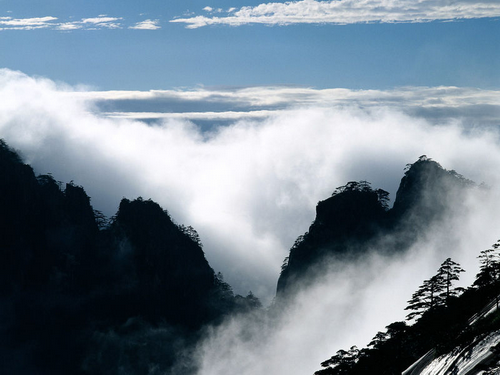 |
| Lushan Mountain in thick cloud |
Lushan Mountain situates south of Jiujiang city in northern Jiangxi province. Solitary and imposing, it towers over the southern bank of the Yangtze River, leaving behind its shadows upon the Poyang Lake. Overlooked southward on top of the mountain, the Poyang Lake is like a silver mirror. In the north, the Yangtse River looks like a jade ribbon flying to the east. This picturesque mountain is famous for its grandeur, elegance and perilous nature.
|
|
Lushan Mountain bristles with lofty peaks in an infinite variety of forms. Some rise sharply from the ground like stone needles while others look dangerously steep or elegant. The best known characteristic of the mountain, perhaps, is the ever-changing mist that wraps up the peaks all the year round. In a poem devoted to the misty Lushan Mountain, Tang Bohu, the celebrated Ming Dynasty painter and calligrapher wrote, " Kuanglu Mountain (the old name of Lushan Mountain), shrouded in dense fog, and rose beyond the highest heavens". And no wonder Su Dongpo, a brilliant poet of the Song Dynasty should have queried in one of his poems: "How could one tell what Lushan Mountain really looks like when one is in the midst of the mountain all along?"
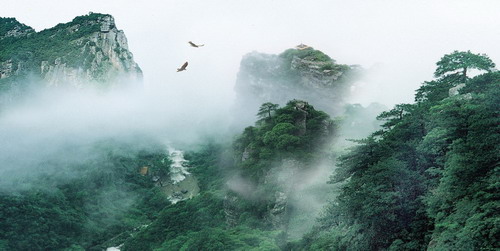 |
|
Lushan Mountain bristles with lofty peaks in an infinite variety of forms. It's like a fairy land. |
Lushan Mountain, is also one of the spiritual centers of Chinese civilization. Buddhist and Taoist temples, along with landmarks of Confucianism, where the most eminent masters taught, blend well into a strikingly beautiful landscape that has inspired countless artists who developed the aesthetic approach to nature found in Chinese culture. The Donglin Temple, built by eminent monks in the Eastern Jin Dynasty, was the birthplace of the Jingtu (Pure Earth) Sect of Buddhism.
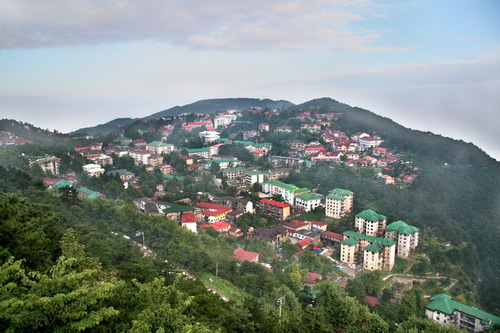 |
| Viewing from the Lushan Mountain |
More than 1,500 noted figures in history visited this mountain, leaving behind some 4,000 pieces of verse and over 900 inscriptions on the cliffs, as well as other writings, prints and calligraphic works. There are about 600 villas here, with the styles of 18 nations and cultures. The scenery in Lushan Mountain scenic area is breathtaking. It is full of sheer peaks and precipices, changeable clouds and fogs, springs and flying waterfalls. Though complicated, the geological structure can be clearly traced. Lushan Mountain is a fault mountain formed in the Quaternary Period. When it rose, the surrounding land sank, and the Poyang Basin eventually developed into the Poyang Lake. The many grotesque rocks, towering peaks and cascading waterfalls constitute a spectacular mountain landscape. With frequent fog and mist, Lushan Mountain has cool summers. It also has typical flora and fauna.
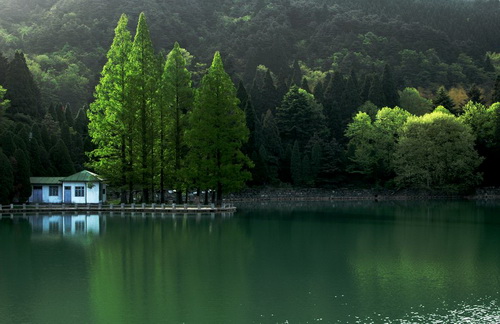 |
| Lulin Lake in Lushan Mountain |
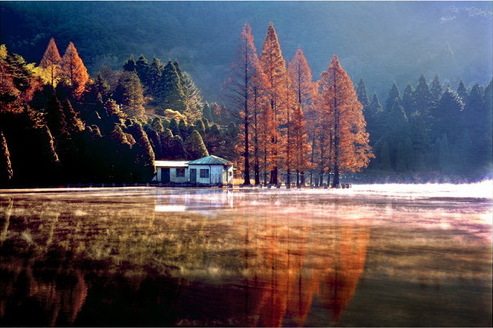 |
| Lulin Lake in autumn |
According to legend, Dayu (the Great Yu), who conquered devastating floods in primeval times, visited Lushan Mountain. Emperor Shihuang of Qin Dynasty (221-206 BC) also visited the mountain when he toured the south. Poets and scholars of every dynasty were attracted to Lushan Mountain and inspired to compose numerous works.
The modern villas are quite a sight on Lushan Mountain. Each villa is an individual building complex with unique style and structure, including styles of Gothic churches, Japanese building and Islamic Mosque. It is this style that enables the villas to be well integrated with the natural scenery. The modern villas on Lushan Mountain, mostly one or two-storied, though in clusters, are less densely located and decorated with trees all around, which is a pleasing picture to the eye. The villa complex is simple and natural in style. Each is like a distinctive geometric figure. You could hardly find two villas that are the same.
Wulao Peaks (Five Peaks in the shapes of five old men): With the best landscape among the peaks of Lushan Mountain, its fourth peak is the highest one and its third one is most precipitous. Far in the distance lies Poyang Lake with a vast expanse of misty and rolling waters. At the foot of the peak are stranger pines, grotesque stones and flying clouds.
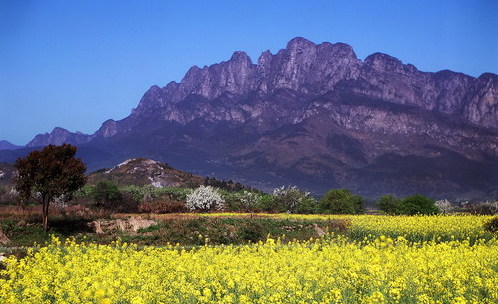 |
| Wulao Peaks (Five Peaks in the shapes of five old men) |
Hanpokou: Hanpokou is the best location for visitors to view sunrise and the sea of clouds. The best time is from mid October to the first half of April. The red sun rises slowly from Poyang Lake, adding radiance to the peak.
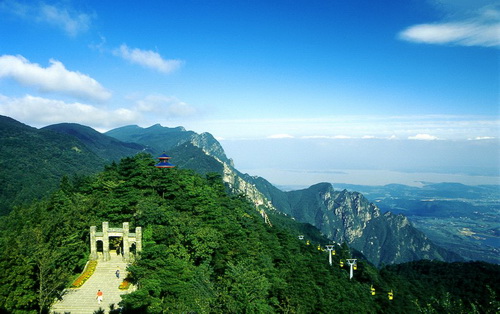 |
| Hanpokou |
Three-Cascade Waterfall: The Three-Cascade Waterfall is the biggest one on Lushan Mountain. Natural and humane landscapes gather together in the scenic area dotted with Nine-Cascade Screen, Yuchuan Gate, Tianmen Pond and Wulao Peaks. The scenic area is linked with the White Deer Academy, Xiufeng Peak and other scenic spots. All blend into one harmonious whole and bring out the best in each other.
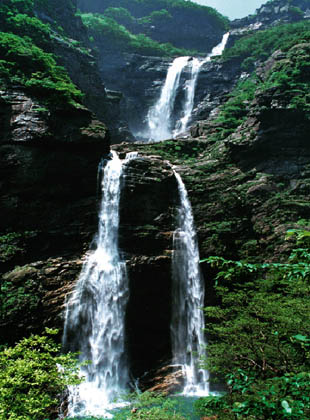 |
| The Three-Cascade Waterfall |
Gantang Lake: Located in the city proper of Jiujiang, Gantang Lake was the place where Zhou Yu, general and navy governor of the Eastern Wu, drilled the navy and deployed troops during the Three Kingdoms. The base of Yanshui Pavilion was the place where Zhou Yu calied the muster roll of the troops and assigned them tasks.
Donglin Temple: Located at the northwestern slope of Lushan Mountain and built in AD 386 by Hui Yuan, a noted monk of the Eastern Jin Dynasty, Donglin Temple is the birthplace of the Pure Land Sect of Chinese Buddhism.
Shizhong Mountain (Stone Bell Mountain): Shizhong Mountain is located on the southeastern bank at the confluence of the Yangtze River and Poyang Lake and known as the "Lock and Key on the south of the Yangtze River". Standing on Shizhong Mountain and viewing the confluence of the river and lake, the river water is muddy and the lake water is clean, clearly demarcating the two colors. Over 500 celebrities of the past dynasties have left more than 1,000 poems and songs.
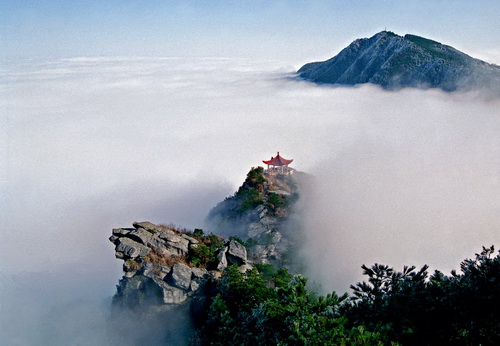 |
| The Little Heaven Pool |





 Website:
Website:  Virtual tour:
Virtual tour: